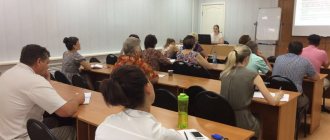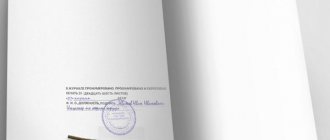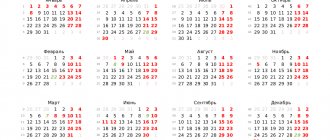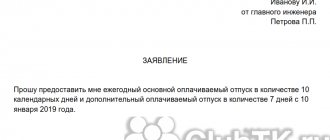What temperature should the workplace be? This issue is especially relevant for employers, because if they fail to create favorable working conditions, they will inevitably face fines. If people work for a long time at high or low air temperatures, their health will be harmed. You can find out what the optimal temperature in the workplace should be set in SanPiN standards and clarifications of Rostrud.
It should be noted that standards are established not only in relation to temperature conditions, but also in relation to humidity and air speed, surface temperature and a number of other parameters. For different professions, the temperature in the workplace will be different; this parameter largely depends on the intensity of physical activity.
SanPiN protects the health of employees
The sanitary standards of the Russian Federation are collected in a special code, which defines optimal hygienic and health standards for various areas of human activity, including employment.
This is documentation related to the medical and technical fields, and at the same time legislative, and therefore mandatory. The abbreviation “SanPiN” stands for Sanitary Rules and Norms,” it is somewhat consonant with SNIPs - building codes and regulations, but they should not be confused, these are documents from different working areas.
REFERENCE! The document regulating optimal conditions in the workplace is called SanPiN 2.2.4.548-96 “Hygienic requirements for the microclimate of industrial premises.” It provides labor protection regulations for office employees (in the text of the law they are classified as category A for labor costs) and production workers. These rules and regulations were adopted within the framework of Federal Law No. 52 “On the sanitary and epidemiological welfare of the population” of March 30, 1999.
The obligation for employers to comply with SanPiN requirements is supported by Art. 209 and Art. 212 of the Labor Code of the Russian Federation, which speaks of responsibility in the strict observance by employers of labor protection rules and timely measures of sanitary, household, hygienic, treatment and prophylactic, rehabilitation and other nature. Art. 163 of the Labor Code of the Russian Federation prescribes a set of measures for employers to ensure an optimal working microclimate.
What requirements are established by SanPiN?
According to Art. 21 of the Labor Code of the Russian Federation, employers are obliged to create the most comfortable conditions in the workplace for their subordinates. First of all, special attention is paid to the safety of people. Also, considerable attention is paid to the microclimate. The fact is that spending most of the time in a stuffy room, a person can acquire many diseases that will become chronic over time. Thus, legislation requires maintaining a certain temperature, humidity and other parameters in production and in the office.
Article 21 of the Labor Code of the Russian Federation
“Basic rights and responsibilities of an employee”
Standard indicators are established taking into account the nature of the employees’ work. So, if workers are constantly moving, then their places are heated less. The situation is different with sedentary activity.
According to SanPiN, the established temperature regime at the place of performance of official duties in the summer should correspond to 23-25 degrees with a humidity of no higher than 60 and no lower than 40 percent. Warming up of surfaces should not go beyond the range of 22-26 degrees, the air flow speed should not exceed 0.1-0.3 m/s.
In winter, classrooms must be heated to 22-24 degrees. The remaining indicators correspond to the above figures. The optimal temperature is considered to be 21-25 degrees Celsius.
Next, you should refer to the table containing summary information about the standard temperature conditions in the workplace:
| Degree of staff activity | Warm w/g, °C | Cold w/g, °C |
| Minimum | 22-25 | 21-24 |
| Slight (walking) | 20-22 | 19-21 |
| High | 19-21 | 17-19 |
| Constant | 18-20 | 16-18 |
What temperature should the office be?
A special document on hygienic requirements for indoor climate was drawn up for office workers (this also applies to medical institutions and schools). By defending your rights, you can take advantage of them. There are sanitary standards that affect the well-being of the population. The law was adopted by the government back in 1999, however, the adopted and established requirements must be strictly observed by the manager for employees of office premises.
The width of the corridor according to fire standards and its length
If an employee is in the office for a standard 8 hours every day, then the employer must provide him with a comfortable temperature (this also applies to people working in shifts):
- for summer days - 23-25 °C;
- on cold days - 22-24 °C.
Note! According to SanPiN requirements, deviations from the accepted standard temperature in the office cannot exceed 1-2 degrees. If this occurs, employees should report the problem to their immediate department manager.
The law also contains information about indoor humidity, which is also of great importance for the human body. The indicator should be approximately 40%, but not exceed 60%. These are optimal working conditions.
Temperature conditions in the workplace - legal regulation
Article 212 of the Labor Code of the Russian Federation (hereinafter referred to as the Labor Code of the Russian Federation) provides for the obligation of employers to provide workers with normal and safe working conditions.
Such conditions include a favorable microclimate in the workplace, which is also characterized by the air temperature in the room. Both the health status of employees and the efficiency and productivity of their work depend on temperature indicators.
Working in hot weather is not directly regulated by the Labor Code of the Russian Federation. Excessive air temperatures in the workplace are also not mentioned among harmful or special working conditions. However, the Ministry of Health of the Russian Federation has developed SanPiN 2.2.4.3359-16 “Sanitary and epidemiological requirements for physical factors in the workplace” (hereinafter referred to as SanPiN), approved by Resolution of the Chief State Sanitary Inspector of the Russian Federation dated June 21, 2016 No. 81.
Note! SanPiN data regulate the maximum temperature in offices, workshops and other premises. They are mandatory for compliance by all employers - both organizations and individual entrepreneurs using the labor of employees (clause 1.2).
Important! The employer is obliged to monitor the temperature in the workplace on a daily basis in accordance with SanPiN. If there are complaints from workers about the heat, measurements should be made 3 times per shift (clause 2.3.1).
What you need to know
Speaking about temperature standards in the workplace and measures to optimize personnel work in winter and summer, we remember about the Resolution of the Chief Sanitary Doctor of Russia dated June 21, 2016 No. 81 “On approval of SanPiN 2.2.4.3359-16 Sanitary and epidemiological requirements for physical factors in the workplace” ( together with SanPiN 2.2.4.3359-16 Sanitary and epidemiological rules and regulations...). This resolution was registered with the Ministry of Justice on August 8, 2016 under No. 43153 and has the status of a valid regulatory document that is binding.
The inevitability of the resolution is achieved not only by registration with the Ministry of Justice, but also by a direct indication in paragraph 1.2 of the SanPiN itself, which states that compliance with the requirements of the rules is mandatory both for citizens who are in labor relations and for individual entrepreneurs and legal entities. Literally, this means that failure to comply with sanitary requirements, including refusal to change working conditions if the air temperature in the workplace does not correspond to optimal indicators, is grounds for imposing a fine under Article 5.27.1 of the Code of Administrative Offenses of the Russian Federation - up to 80,000 rubles.
Next, let's take a closer look at the sanitary requirements and tell you how to navigate the temperature and what to do in each case.
How it works
SanPiN 2.2.4.3359-16 does not apply to divers and cosmonauts, to the conditions for performing emergency rescue operations or combat missions (by whom, it is not specified, but obviously we are talking about rescuers and firefighters).
Further, SanPiN 2.2.4.3359-16 indicates that it imposes requirements for workplaces. SanPiN does not explain what workplaces are, but paragraph 2.1.2 states that hygienic requirements for microclimate indicators are established for workplaces in production premises. This means that formally SanPiN regulate at what temperature indoors you cannot work, and those who have to work outdoors, for example, road workers, the rules do not apply (they do, of course, but what to do if it’s written like that).
Now about the production environment and microclimate.
There are five microclimate indicators:
- air temperature;
- surface temperature;
- relative humidity;
- air (wind) speed;
- intensity of thermal radiation.
Together, they provide a comfortable environment in which working conditions are optimal.
What is not included in these indicators, but is taken into account by SanPiN, is the clothing in which a person works. It is hot to work in cloth, and sometimes uncomfortable overalls discourage workers from working. Let's look at the special rules. For a unit of SanPiN clothing, they charge a set of items with thermal insulation of 1 CLO in the cold season and 0.7 - 0.8 CLO in the warm season for an 8-hour work shift.
CLO is a unit of measurement for the insulation properties of clothing. To immediately avoid questions like “how much CLO is in regular jeans or a T-shirt,” let’s say that this is a relative value. 1 CLO is the amount of clothing you need to feel comfortable. Let's give this example: the temperature in the workroom for knowledge workers should be within +25 ° C so that a person who is just sitting at a computer feels comfortable. But if he gets up and swings a sledgehammer 30 times, then the temperature will seem comfortable up to +10. What is important to understand here is that clothes retain heat, but do not produce it. If clothing is heated, it will also warm the worker (if it is not special clothing). If the worker himself is heated, then his clothes retain heat and cause overheating of the worker himself. CLO does not affect the physical performance of the workplace, but it does affect the person and therefore must be taken into account.
How should the temperature be measured?
Since labor time depends on the temperature of 1 degree, when taking measurements you must be guided by strictly established rules. Any error can lead to violation of sanitary standards and illness of employees. If the employer performs his duties in bad faith, there is often a deliberate change in the measurement results. Errors also occur when using inaccurate instruments or placing them incorrectly.
In order to carry out measurements correctly, you must follow the requirements specified in the legislation. The standards establish the need to place equipment at a distance of a meter from the floor.
What should the air temperature be when working in office and other premises?
What should be the temperature in the workroom?
In accordance with SanPiN, the optimal temperature in the room where workers work in the warm season should be from 18 to 25 degrees (clause 2.2.5 of SanPiN). Temperatures above 25 and up to 28 degrees are acceptable.
Important! Exceeding 28 degrees is considered excessive and harmful to health.
If it is determined that the permissible air temperature in the workplace is exceeded, the employer is obliged to take a number of measures to minimize harm to the health of employees. The list of such measures is published annually by Rospotrebnadzor and the Ministry of Labor of the Russian Federation on official websites.
Among them:
- installation of air conditioners and fans;
- providing workers with cool drinking water;
- introduction of additional work breaks;
- redistribution or shift of working hours to early morning and/or late evening hours in agreement with employees;
- availability of a first aid kit to provide first aid in case of overheating or heat stroke;
- reduction of working hours;
- provision of short-term annual paid leaves outside the schedule (by agreement between the employer and employee).
The importance of office climate
Temperature conditions greatly influence the well-being and performance of people. Increased or decreased air temperature, which affects an employee for a long time, not only has a negative impact on health, but also sharply reduces labor productivity. Office employees perform a wide variety of activities, most of which involve spending a long time in the same position, usually sitting and sedentary:
- work at a computer;
- draw up paperwork;
- communicate with clients;
- make decisions, etc.
Mental work and physical inactivity do not go well with an uncomfortable room temperature. Researchers have experimentally found that deviations even within one degree have such a strong impact on the efficiency of office work that it makes sense to even shorten the working day if it is impossible to provide the proper microclimate.
IMPORTANT! Ensuring proper temperature conditions in the office is a legal obligation of the employer, regardless of the form of ownership and level of subordination of the organization.
Temperature standards in the workplace
Average optimal temperature conditions depend on operating conditions and time of year. The less energy is consumed during work, the higher this indicator should be:
- for office workers: in the warm season - 23–25 °C, in the cold season - 22–24 °C;
- for workers with light physical activity: in summer - 22–24 °C, in winter - 21–23 °C;
- for persons whose work involves walking and light physical activity: in summer - 20–22 °C, in winter - 19–21 °C;
- for employees whose work requires increased physical activity: in summer - 19–21 °C, in winter - 17–19 °C;
- for workers with high physical activity: in summer - 18–20 °C, in winter - 16–18 °C.
Permissible air temperature in the workplace
SanPiN 2.2.4.548-96 standards provide for small deviations from the optimal temperature in the workplace. Changes in these values up to 4–6 °C are possible.
If working conditions suggest a deviation from the optimal values and permissible temperature standards in the workplace, employees have legal grounds to reduce their working hours. The higher the deviation level, the shorter the working day. For example, at a workplace temperature of about 13 °C, the permissible work duration for office employees is no more than an hour.
Rospotrebnadzor spoke about how to reduce the length of the working day in the heat.
Seasonal requirements for office temperature
In cold and warm seasons, ensuring optimal temperature is achieved in different ways. Accordingly, the requirements for the microclimate will differ, as well as the measures provided for by SanPiN in the event of the impossibility of ensuring the temperature regime or its serious violations.
So that it doesn't get too hot
Prolonged exposure to elevated temperatures is particularly detrimental to the performance and health of workers. In a closed work space, it can be aggravated by large crowds of people, the presence of working office equipment, and compliance with a special dress code.
In this regard, the optimal temperature values and the permissible maximum during the hot period of the year are legally established. For office workers they are 23-25°C with a relative humidity of 40-60%. Temperature increases up to 28°C are allowed.
Exceeding summer temperatures in the office
If the thermometer inside the office deviates from the optimum by more than 2°C, it becomes much more difficult to work. The employer will have to supply air conditioning for employees and ensure its normal operation and timely maintenance.
If for some reason this is not done, the employee should not meekly endure the sweltering heat, while also trying to meet professional requirements. Sanitary standards allow workers to rightfully shorten the standard eight-hour working day, for which the temperature requirements are designed:
- 29°C allows you to work 6 hours instead of 8;
- 30°C allows for a two-hour contraction;
- each subsequent degree exceeding the norm reduces the working time requirements by another 1 hour;
- if the thermometer reaches 32.5°C, you don’t have to stay at work for more than 1 hour.
FOR YOUR INFORMATION! Many employees note the negative impact of air conditioning, comparable in harm to heat and stuffiness. The same requirements of SanPiN, along with temperature and humidity, limit the speed of air movement in the room, which should not go beyond the range of 0.1-0.3 m/s. It follows that the employee should not be under the blowing air conditioner.
Cold is the enemy of work
In a room that is too cold, no work is possible, especially office work, when the body cannot warm itself with movement. If for some categories of production workers a drop in ambient temperature to 15°C is acceptable, and even then short-term, for white-collar workers this is unacceptable.
During the cold period of the year, a comfortable temperature value should be maintained indoors - 22-24°C. Fluctuations in the norm of up to 1-2°C are acceptable, and for a short time during the working day the thermometer column can “jump” by 3-4°C.
Professions by job category
| Ia | Mostly sitting work: personnel, accounting, seamstresses, watchmakers, typesetters, proofreaders, etc. |
| Ib | Work performed both sitting and moving: librarians, various types of controllers, including in transport, etc. |
| IIa | Work that involves constant walking: pizza delivery people, couriers (the weight of the delivered cargo does not exceed a couple of kilograms), etc. |
| IIb | Work related to moving weights up to 10 kilograms: loaders, mechanics, etc. |
| III | Work associated with moving weights over 10 kilograms or requiring constant physical effort: foundry workers, etc. |
Knowing which energy consumption category your professional activity falls into, you can easily determine the optimal values for your microclimate.
But what to do if these values deviate greatly from normal values? For this purpose, there are special tables that establish work rules if the temperature standard in the workplace does not correspond to optimal values.
Working hours in the office depending on air temperature
Air conditioning - enemy or friend
Experts say that an air conditioner can quickly and efficiently cool a room, but at the same time it negatively affects a person’s health if he is constantly exposed to a stream of cold air (for the same reason, installing a cooling device in educational institutions is not recommended, since a student may catch a cold) .
Therefore, when turning on the air conditioner, the employer must make sure that no employee is directly exposed to the air coming from the installed split system (in this case, it is better to limit ventilation). Otherwise, you will have to pay sick leave in the near future.
Working outdoors in hot weather
Organizing normal working conditions in the heat outdoors is much more difficult than indoors.
Note! This issue is not regulated either by the norms of the Labor Code of the Russian Federation or by the above-mentioned SanPiN. However, Rospotrebnadzor of the Russian Federation annually publishes recommendations on organizing work in hot summer conditions (see, for example, “Recommendations of Rospotrebnadzor for those working in conditions of elevated air temperatures” dated 08/06/2018). These recommendations must be followed by all employers organizing work outdoors at elevated temperatures.
At air temperatures of 32.5 degrees and above, work should be organized with regular breaks in cool rooms (24-25 degrees) for 10-12 minutes every 15-20 minutes. The total duration of work in hot weather should not be more than 4-5 hours with special protective clothing and 1-1.5 hours without it.
Important! If the temperature is close to 37 degrees, then it is not recommended to work outdoors.
When working outdoors during hot periods, drinking regime must be maintained. Workers should be given the opportunity to drink cool water, tea, and other drinks often and little by little (about 1 cup every 20 minutes). It is also recommended to drink alkaline mineral water, fermented milk drinks, and juices to replenish the loss of salts and trace elements.
Note! Pregnant women, people over 40 and under 25 years old should not be allowed to work in hot weather.
Risk! For violation of the rules and standards of safe working conditions, the employer bears administrative liability under Art. 6.3 of the Code of Administrative Offenses of the Russian Federation in the form of a fine of up to 20,000 rubles or administrative suspension of activities for up to 90 days.
Ventilation of premises: SanPiN standards
If the office gets too hot in the summer, the employer needs to purchase fans or install a split system in the room. But at the same time, it is necessary to ensure that the cooled air of a working air conditioner does not fall directly on a person, otherwise there is a risk that he will get sick and will have to pay sick leave, and not a fine for violating SanPin standards.
Important! Ventilating rooms and installing high-quality ventilation is another way to lower the temperature, but not the most effective.
Shortening the working day if the temperature in the workplace is too high
In accordance with the norms of SanPiN, depending on how much the temperature regime in the premises is exceeded, the duration of the working day should be reduced by 1, 2, 3 or more hours (Appendix 3).
We recommend. When reducing the working day, the physical activity of workers should also be taken into account. Thus, for office employees who move little and occupy a mostly sitting position, the maximum air temperature in the room according to SaNPiN will be different than, for example, the maximum permissible temperature when working in a workshop for an employee carrying heavy loads.
The table below shows what the maximum duration of a working day can be, depending on the air temperature and the activity of employees.
The time for which the working day is shortened is paid in accordance with Part 2 of Art. 157 of the Labor Code of the Russian Federation (as downtime for reasons beyond the control of the employer and employee).
How does the length of the working day change if the room is cold?
This problem is especially relevant for office workers. Their sedentary nature of activity does not allow them to warm up in a cold room. Because of this, employee productivity decreases. A decrease in temperature to 15 degrees is allowed only if a person performs tasks related to physical activity. As noted earlier, the optimal mode that meets the requirements of established standards is to warm up offices to 21-24°C. In this case, the maximum permissible deviations should not exceed 2°C. If the temperature difference is short-term, then a jump range of 4°C is allowed.
The duration of performance of official duties in this case will be as follows:
- 19°C – seven-hour working day;
- 18°C – 6 hours and so on;
- at a temperature of 13°C, office workers can perform their duties for only 1 hour (if the activity is sedentary).
SanPin requirements for production premises
Certain SanPiN requirements have been established for production premises or offices. If the temperature in a workplace (the standards are officially enshrined in laws) deviates from acceptable parameters, the manager, according to the rules, must limit the time an official spends at the workplace or take care of improving conditions.
SanPin
For example, an eight-hour standard working day is maintained only under conditions where the room temperature is no more than 28°C and no less than 20°C. Extra or missing degrees reduce the working day by 1 hour.
For this reason, special thermometers must be installed in each production or office premises at a height of approximately 1 m from the floor in order to monitor compliance with working conditions established at the official level. If the conditions do not meet the requirements, the employee must receive work with additional pay at an industrial establishment.
What does GIT say about this?
GIT specialists, commenting on the temperature at which the working day is shortened in the summer in the office, explain: if there is not enough money to create comfortable conditions (purchase of the same fans and heaters), it is permissible to introduce downtime for reasons beyond the control of both the employer and the employee.
Another option is for the administration to transfer employees to work from home during abnormal temperatures, extend their rest and meal breaks, or completely change the staff’s work schedule. True, for such forced innovations as shortening the working day at high temperatures or downtime, the employer will have to enter into additional agreements to the employment contracts. The editors of Clubtk.ru believe that it is more convenient to introduce these provisions into the PVTR and, when certain circumstances occur, simply issue an order.
As for working in the cold, there are certain general rules. Thus, in accordance with Article 109 of the Labor Code of the Russian Federation, some categories of workers need to establish additional breaks for heating and rest, and this time is included in working hours. Rostrud reminds that only those citizens who do not have any medical contraindications for working in the cold are allowed to work in the cold. And employees are required to be provided with weather-appropriate personal protective equipment.
Speaking about special breaks for heating, officials remind that their number and duration are established by acts of the employer, and they depend not only on the air temperature, but also on the strength of the wind. One of the responsibilities of the organization is to ensure a temperature of 21 - 25 degrees in heating areas, installing special equipment that maintains a temperature of 35 - 40 degrees to warm hands and feet.
Rostrud reminds that the employer is obliged to provide subordinates with normal working conditions and is liable, even criminally, for inaction and causing harm to the health of the employee. To avoid this, officials propose to study and begin to implement the methodological recommendations of the Chief State Sanitary Doctor “Work and rest regimes for workers in cold weather in open areas or in unheated premises” (MP 2.2.7.2129-06).
What to do if it's cold in the office
In order to create comfortable working conditions for employees in winter, the employer is obliged to additionally purchase heaters for the office if the temperature regime according to SanPiN is violated.
Another way out of this situation is to invite workers who will check the pipeline through which hot water for heating flows. Perhaps the pipes were clogged, and therefore the room was poorly heated.
A worker clears a clogged pipe
What should an employee do if the employer does not comply with the temperature regime?
Salaried workers often face negligence from their employers. What to do in this case? There are several options:
- ask the employer to normalize the temperature using equipment (air conditioning, heater)
- demand a reduction in hours of work in accordance with regulations
- file a complaint with Rospotrebnadzor
- contact the labor inspectorate for help
In the last two options, a special inspection will be carried out at the place of work, during which it will be determined whether an offense has been committed.
As a result, we can say that the employee has several legal methods of influencing the employer.
How to protect your rights in case of violation in the workplace?
An employee must independently take certain actions if he understands that the microclimate established in the room where he has to spend most of the day may adversely affect his well-being or health.
The first way out of the situation is to temporarily leave responsibilities. To do this, an official application is prepared addressed to the manager. The text must include information that following the job description may lead to a risk of loss of health. In addition, it is recommended to refer to Art. 379 of the Labor Code of the Russian Federation, indicating the legality of these actions. This method of conveying your position to your superiors is rarely used in practice.
Article 379 of the Labor Code of the Russian Federation – Forms of self-defense
For the purpose of self-defense of labor rights, an employee, having notified the employer or his immediate supervisor or other representative of the employer in writing, may refuse to perform work not provided for in the employment contract, as well as refuse to perform work that directly threatens his life and health, except in cases provided for by this Code and other federal laws. During the period of refusal of the specified work, the employee retains all rights provided for by labor legislation and other acts containing labor law norms. For the purpose of self-defense of labor rights, an employee has the right to refuse to perform work also in other cases provided for by this Code or other federal laws.
The second method is to gradually convey relevant information about the indoor microclimate to the organization's managers. It is used almost always. For this:
- An appeal is drawn up addressed to higher authorities with a demand to take measures to eliminate violations associated with heating of the premises and humidity in them. For this, various options are offered, including the purchase and installation of special equipment (air conditioner, humidifier, etc.).
- If the situation does not change, the citizen must declare his right to a shortened working day. In this case, you must refer to . It is worth noting that employers can simply circumvent the requirement by reducing the time a person is on site (increasing the number of breaks).
- If the above methods do not work, then the only option is to file a complaint against the organization with Rospotrebnadzor and the labor inspectorate. The latter structures check the fact of the application and confirm or deny the presence of violations. This is an extreme, but quite effective measure.
The employer is interested in the productive work of his subordinates and does not deliberately worsen working conditions. Therefore, the problem, as a rule, is resolved at the stage of the employee’s personal appeal to his superiors.
Employer's liability for failure to comply with office microclimate requirements
If management does not want to fulfill its responsibilities to provide staff with optimal working conditions, for example, does not install the necessary air conditioning in hot weather or a heater in the cold season, employees should not tolerate their arbitrariness for fear of dismissal. After contacting the sanitary and epidemiological service, the organization will be subject to an inspection, and if the claims are confirmed, administrative liability cannot be avoided.
In addition to the inevitable requirements to eliminate violations, a negligent employer will be issued a serious fine in the amount of 10-12 thousand rubles. And if he does not correct himself in time, then his activities may be stopped for 3 months (Article 6.3 of the Code of Administrative Offenses of the Russian Federation).
What consequences await the employer for violating the current legislation?
If for some reason the employer cannot comply with the norms established by legal acts, the length of the working day is reduced. Otherwise, non-compliance with the regime is qualified in accordance with Part 1 of Art. 5.27.1 Code of Administrative Offences. If an employer is held liable, he may face the following penalties in the form of a fine:
- 2-5 thousand rubles – for persons engaged in entrepreneurial activities;
- 50-80 thousand rubles – for legal entities;
- 2–5 thousand rubles – in relation to officials.
A warning or forced suspension of activities for a period of up to three months is also possible.
Expert commentary
Gorchakov Vladimir
Lawyer
Despite the fact that inspectors are guided by the previously mentioned article to influence a negligent employer, they can bring him to justice with the use of milder sanctions. So, according to Art. 6.3 of the Code of Administrative Offenses of the Russian Federation, the culprit faces a warning and an administrative penalty in the amount of 100 rubles to 20 thousand rubles. The exact amount depends on the legal status (individual, manager, entrepreneur, legal entity).
Results
Ensuring the required temperature level at employee workplaces is the responsibility of the employer. The rights of workers to comfortable working conditions, including maintaining the proper level of temperature in the workplace, are established by the provisions of the Labor Code of the Russian Federation.
To avoid conflict situations, employers are recommended to equip workplaces with air conditioning or heating. Failure to comply with these conditions may result in fines or suspension of the entity's activities.
Sources
- https://assistentus.ru/trudovoe-pravo/normy-temperatury-v-ofise/
- https://lawinfo24.ru/trudovoe-pravo/trudovye-otnosheniya/normy-temperatury-na-rabochem-meste
- https://VyborPrava.com/trud/rabotodatel/temperatura-v-pomeshhenii-po-trudovomu-kodeksu.html
- https://rusjurist.ru/kadry/pri-kakoj-temperature-nelzya-rabotat-v-pomeshenii-soglasno-normam-sanpin/
- https://clubtk.ru/zhara-ili-kholod-kogda-pora-sokrashchat-rabochiy-den
- https://nalog-nalog.ru/ohrana_truda/kakaya_temperatura_dopustima_na_rabochem_meste_normy/
What is meant by comfortable working conditions and optimal conditions?
Hygienic standards for working conditions
Any office employee must fulfill a list of established duties during the working day. And comfortable working conditions are an environment that does not interfere with this.
Optimal working conditions in an office or at an enterprise are a given climate in which an employee can work without being distracted by weather factors. In other words, a person should not be too cold in winter and too hot on summer days.
The employee will stop focusing on duties in hot or cold weather
The importance of office climate
For performing work duties during the working day, the employee receives a salary and is given leave. In turn, the manager receives his own profit. But if the microclimate in the room is disturbed and a person suffers from heat or cold, he will not be able to concentrate on performing his duties. This will result in his boss receiving poor quality work or missed schedules and deadlines.









